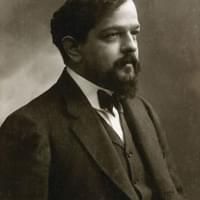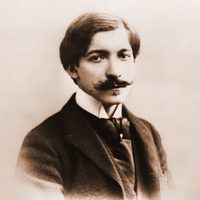Le tombeau des Naiades
French source:
Pierre Louÿs
devant ma bouche se fleurissaient de petits glaçons, et
mes sandales étaient lourdes de neige fangeuse et tassée.
Il me dit: «Que cherches-tu?»—«Je suis la trace du satyre.
Ses petits pas fourchus alternent comme des trous dans
un manteau blanc.» Il me dit: «Les satyres sont morts.
«Les satyres et les nymphes aussi. Depuis trente ans il
n’a pas fait un hiver aussi terrible. La trace que tu vois est
celle d’un bouc. Mais restons ici, où est leur tombeau.»
Et avec le fer de sa houe il cassa la glace de la source
où jadis riaient les naïades. Il prenait de grands
morceaux froids, et les soulevant vers le ciel pâle, il
regardait au travers.
The tomb of the Naiads
English translation ©
Richard Stokes
my mouth, blossomed with tiny icicles, and my
sandals were heavy with muddy, packed snow.
He said to me: ‘What do you seek?’ ‘I follow the satyr’s track.
His little cloven hoof-marks alternate like holes in
a white cloak.’ He said to me: ‘The satyrs are dead.
‘The satyrs and the nymphs too. For thirty years there
has not been so harsh a winter. The tracks you see are those
of a goat. But let us stay here, where their tomb is.’
And with the iron head of his hoe he broke the ice of
the spring, where the naiads used to laugh. He picked up
some huge cold fragments, and, raising them to the pale sky,
gazed through them.
Translation © Richard Stokes, author of A French Song Companion (Oxford, 2000)
Le tombeau des Naiades
French source:
Pierre Louÿs
The tomb of the Naiads
English source:
Richard Stokes
Le long du bois couvert de givre, je marchais; mes cheveux
Along the frost-bound wood I walked; my hair across
devant ma bouche se fleurissaient de petits glaçons, et
my mouth, blossomed with tiny icicles, and my
mes sandales étaient lourdes de neige fangeuse et tassée.
sandals were heavy with muddy, packed snow.
Il me dit: «Que cherches-tu?»—«Je suis la trace du satyre.
He said to me: ‘What do you seek?’ ‘I follow the satyr’s track.
Ses petits pas fourchus alternent comme des trous dans
His little cloven hoof-marks alternate like holes in
un manteau blanc.» Il me dit: «Les satyres sont morts.
a white cloak.’ He said to me: ‘The satyrs are dead.
«Les satyres et les nymphes aussi. Depuis trente ans il
‘The satyrs and the nymphs too. For thirty years there
n’a pas fait un hiver aussi terrible. La trace que tu vois est
has not been so harsh a winter. The tracks you see are those
celle d’un bouc. Mais restons ici, où est leur tombeau.»
of a goat. But let us stay here, where their tomb is.’
Et avec le fer de sa houe il cassa la glace de la source
And with the iron head of his hoe he broke the ice of
où jadis riaient les naïades. Il prenait de grands
the spring, where the naiads used to laugh. He picked up
morceaux froids, et les soulevant vers le ciel pâle, il
some huge cold fragments, and, raising them to the pale sky,
regardait au travers.
gazed through them.
Composer
Claude Debussy
(Achille) Claude Debussy was a French composer. He is sometimes seen as the first Impressionist composer, although he vigorously rejected the term. He was among the most influential composers of the late 19th and early 20th centuries. Please click…
Poet
Pierre Louÿs
Pierre Louÿs was a French poet and writer, best known for his classical themes and sensual style. Read more here.

